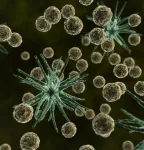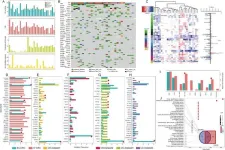(Press-News.org) Levels of grey matter in two parts of the brain may be linked to a desire to start smoking during adolescence and the strengthening of nicotine addiction, a new study has shown.
A team of scientists, led by the universities of Cambridge and Warwick in the UK and Fudan University in China, analysed brain imaging and behavioural data of over 800 young people at the ages of 14, 19 and 23.
They found that, on average, teenagers who started smoking by 14 years of age had markedly less grey matter in a section of the left frontal lobe linked to decision-making and rule-breaking.
Grey matter is the brain tissue that processes information, and contains all of the organ’s neurons. While brain development continues into adulthood, grey matter growth peaks before adolescence.
Low grey matter volume in the left side of the ventromedial prefrontal cortex may be an “inheritable biomarker” for nicotine addiction, say researchers – with implications for prevention and treatment.
In addition, the scientists found that the opposite, right part of the same brain region also had less grey matter in smokers.
Importantly, loss of grey matter in the right prefrontal cortex appears to speed up only after someone has started smoking. This region is linked to the seeking of sensations.
The team argue that less grey matter in the left forebrain could lower cognitive function and lead to “disinhibition”: impulsive, rule-breaking behaviour arising from a limited ability to consider consequences. This may increase the chances of smoking at a young age.
Once a nicotine habit takes hold, grey matter in the right frontal lobe shrinks, which may weaken control over smoking by affecting “hedonic motivation”: the way pleasure is sought and managed. Excessive loss of grey matter in the right brain was also linked to binge drinking and marijuana use.
Taken together, the findings point to a damaged “neurobehavioural mechanism” that can lead to nicotine use starting early and becoming locked into long-term addiction, say researchers. The study used data from the IMAGEN project and is published today in the journal Nature Communications.
“Smoking is perhaps the most common addictive behaviour in the world, and a leading cause of adult mortality,” said Prof Trevor Robbins, co-senior author from Cambridge’s Department of Psychology.
“The initiation of a smoking habit is most likely to occur during adolescence. Any way of detecting an increased chance of this, so we can target interventions, could help save millions of lives.”
Annual deaths from cigarettes are expected to reach eight million worldwide by the end of the decade. Currently, one in five adult deaths each year are attributed to smoking in the US alone.
“In our study, reduced grey matter in the left prefrontal cortex is associated with increased rule-breaking behaviour as well as early smoking experiences. It could be that this rule-breaking leads to the violation of anti-smoking norms,” said Robbins.
Co-author Prof Barbara Sahakian from Cambridge’s Department of Psychiatry said: “The ventromedial prefrontal cortex is a key region for dopamine, the brain’s pleasure chemical. As well as a role in rewarding experiences, dopamine has long been believed to affect self-control.
“Less grey matter across this brain region may limit cognitive function, leading to lower self-control and a propensity for risky behaviour, such as smoking.”
The study used data gathered by the IMAGEN project from sites in four European countries: UK, Germany, France and Ireland. The researchers compared brain imaging data for those who had smoked by age 14 with those who had not, and repeated this for the same participants at ages 19 and 23.
Those with smoking experience by 14 years of age had significantly less grey matter in the left prefrontal cortex, on average. Additionally, those who started smoking by age 19 also had less grey matter in their left prefrontal cortex at 14, indicating a potential causal influence.
The scientists also looked at the right ventromedial prefrontal cortex. Grey matter loss occurs in everyone as they age. However, those who smoked from age 14 as well as those smoking from age 19 both ended up with excessive grey matter loss in the right frontal lobe.
For the right prefrontal cortex, 19-year-old smokers who did not start during adolescence had similar grey matter levels at age 14 to those who never smoked at all. This suggests a rapid reduction in the right ventromedial prefrontal cortex only begins with the onset of smoking.
Data at age 23 showed that grey matter volume in the right prefrontal cortex shrank at a faster pace in those who continued to smoke, suggesting an influence of smoking itself on prefrontal function.
Researchers also analysed data from two questionnaires completed by participants to investigate the personality traits of novelty seeking and sensation seeking.
“Both questionnaires examine the pursuit of thrilling experiences, but they measure distinct behaviours,” said Robbins. “The sensation seeking scale focuses on pleasurable experiences, while the novelty seeking questionnaire includes items on impulsiveness and rule-breaking.”
Less grey matter in the left prefrontal cortex was associated with novelty seeking, particularly disorderly and rule-breaking behaviour, while reduced grey matter volume in the right prefrontal cortex was linked to sensation seeking only.
Lead author Prof Tianye Jia from Fudan University added: “Less grey matter in the left frontal lobes is linked to behaviours that increase the likelihood of smoking in adolescence.
“Smokers then experience excessive loss of grey matter in the right frontal lobes, which is linked to behaviours that reinforce substance use. This may provide a causal account of how smoking is initiated in young people, and how it turns into dependence.”
END
Reduced grey matter in frontal lobes linked to teenage smoking and nicotine addiction – study
2023-08-15
ELSE PRESS RELEASES FROM THIS DATE:
Infants admitted to ICUs for RSV infection during the 2022 seasonal peak
2023-08-15
About The Study: In this study, most U.S. infants who required intensive care for respiratory syncytial virus (RSV) lower respiratory tract infections were young, healthy, and born at term. These findings highlight the need for RSV preventive interventions targeting all infants to reduce the burden of severe RSV illness.
Authors: Natasha Halasa, M.D., M.P.H., of the Vanderbilt University Medical Center in Nashville, and Angela P. Campbell, M.D., M.P.H., of the Centers for Disease Control and Prevention in Atlanta, are the corresponding authors.
To access the embargoed study: Visit our For The Media website at this ...
Communication of COVID-19 misinformation on social media by physicians in the US
2023-08-15
About The Study: In this study of high-use social media platforms, physicians from across the U.S. and representing a range of medical specialties were found to propagate COVID-19 misinformation about vaccines, treatments, and masks on large social media and other online platforms and that many had a wide reach based on number of followers.
Authors: Sarah L. Goff, M.D., Ph.D., of the University of Massachusetts, Amherst, is the corresponding author.
To access the embargoed study: Visit our For ...
Study explains how part of the nucleolus evolved
2023-08-15
Inside all living cells, loosely formed assemblies known as biomolecular condensates perform many critical functions. However, it is not well understood how proteins and other biomolecules come together to form these assemblies within cells.
MIT biologists have now discovered that a single scaffolding protein is responsible for the formation of one of these condensates, which forms within a cell organelle called the nucleolus. Without this protein, known as TCOF1, this condensate cannot form.
The findings could help to ...
Lundquist Principal Investigator Dr. Michael Yeaman awarded $11.5 million NIAID/HHS grant for innovative research to understand and solve persistent bloodstream infections
2023-08-15
The Lundquist Institute (TLI) at Harbor-UCLA Medical Center announced today that TLI Principal Investigator, Michael Yeaman, PhD, has been awarded a grant totaling $11.5M from the National Institute of Allergy and Infectious Diseases (NIAID), Department of Health & Human Services. Along with his role at TLI, Dr. Yeaman is Professor of Medicine at UCLA, and Chief, Division of Molecular Medicine at Harbor-UCLA Medical Center.
This new NIH U19 Center program will decode patterns of the human immune system and microbial pathogens that result in infections that are not ...
Study finds most infants receiving ICU-level care for RSV had no underlying medical condition
2023-08-15
Most infants admitted to the intensive care or high acuity unit for respiratory syncytial virus (RSV) infections during fall 2022 were previously healthy and born at term, according to a new study reported in JAMA Network Open.
The findings from this study support the use of preventative interventions in all infants to protect them from RSV, the leading cause of lower respiratory tract infections (LRTI) and hospitalizations worldwide.
RSV accounts for about 57,000-80,000 hospitalizations in children younger than 5 years with 1 in 5 RSV-positive hospitalized children being admitted ...
Making sense of life’s random rhythms
2023-08-15
CLEVELAND–Life’s random rhythms surround us–from the hypnotic, synchronized blinking of fireflies…to the back-and-forth motion of a child’s swing… to slight variations in the otherwise steady lub-dub of the human heart.
But truly understanding those rhythms—called stochastic, or random, oscillations—has eluded scientists. While researchers and clinicians have some success in parsing brain waves and heartbeats, they’ve been unable to compare or catalogue an untold number of variations and sources.
Gaining such insight into the underlying ...
Robotic exoskeletons and neurorehabilitation for acquired brain injury: Determining the potential for recovery of overground walking
2023-08-15
East Hanover, NJ. August 15, 2023. A team of New Jersey researchers reviewed the evidence for the impact of robotic exoskeleton devices on recovery of ambulation among individua5ls with acquired brain injury, laying out a systematic framework for the evaluation of such devices that is needed for rigorous research studies. The open access article, "Lower extremity robotic exoskeleton devices for overground ambulation recovery in acquired brain injury – A review” (doi: 10.3389/fnbot.2023/1014616), was published ...
New genetic relations between irritable bowel syndrome and psychiatric diseases discovered
2023-08-15
We have all felt the workings of the so called “brain-gut-axis”, how our intestines get affected, for example, by stress. But still, researchers don’t know a lot about the relation between our gut and our brain.
Research has identified genetic correlations between patients suffering from irritable bowel syndrome (IBS) and psychiatric disorders, such as bipolar disorder.
By using new statistical methods, developed at NORMENT Centre, Post Doctor Markos Tesfaye at the University of Bergen and University of Oslo and his colleagues working under the leadership ...
First-of-its-kind study reveals predictive factors for outcomes of advanced stage AL amyloidosis
2023-08-15
(WASHINGTON, August 15, 2023) – Early improvements in cardiac and hematologic parameters may predict better survival outcomes for patients being treated for stage IIIb AL amyloidosis, a deadly disease with a median survival of 4-6 months caused by abnormal protein buildup, according to new research released today in Blood Advances.
Amyloidosis occurs when normal proteins in the body misfold and form amyloid deposits in vital organs and tissues, which can lead to organ dysfunction, failure, and death. The prognosis for patients with advanced cardiac amyloidosis is extremely poor, ...
Innovative research on schistosomiasis-associated colorectal cancer (SA-CRC) yields unique insights into genetic mutations and treatment implications
2023-08-15
In a study published in the journal Genes & Diseases, researchers from Naval Medical University and Soochow University conducted an in-depth investigation into the genomic landscape of schistosomiasis-associated colorectal cancer (SA-CRC). By utilizing whole exome sequencing on tumor tissues and their non-tumor counterparts obtained from thirty SA-CRC patients diagnosed at Changzheng Hospital from 2014 to 2020, the team successfully identified 2476 nonsynonymous mutations spanning across 1978 genes. This intricate analysis revealed a lower median tumor mutation burden (TMB) in SA-CRC compared to sporadic colorectal cancer (S-CRC), ...





